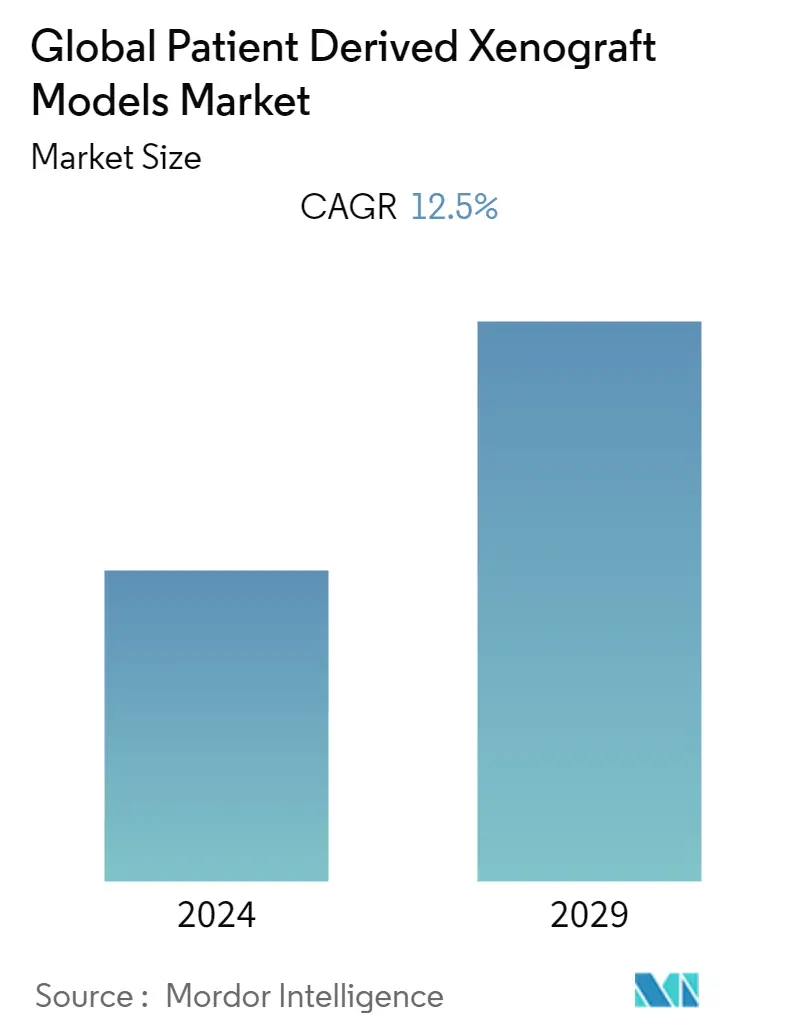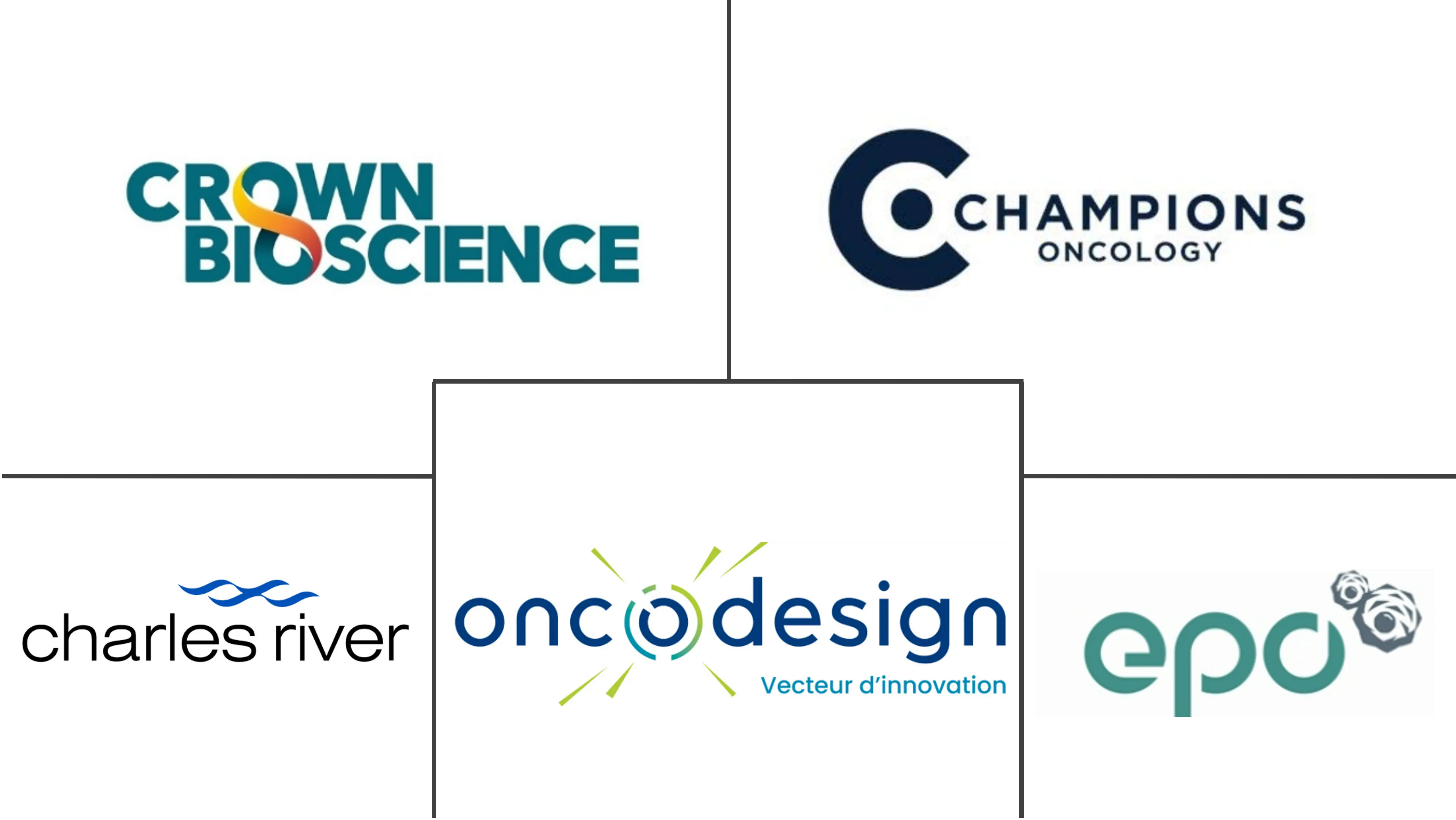
| Study Period | 2019 - 2029 |
| Base Year For Estimation | 2023 |
| Forecast Data Period | 2024 - 2029 |
| CAGR | 12.50 % |
| Fastest Growing Market | Asia Pacific |
| Largest Market | North America |
| Market Concentration | High |
Major Players
*Disclaimer: Major Players sorted in no particular order |
Patient Derived Xenograft Models Market Analysis
The patient-derived xenograft models market is expected to register a CAGR of 12.5% over the forecast period.
During the COVID-19 pandemic, cancer research was halted as the majority of studies were focused on developing drugs for COVID-19. However, post-pandemic, the majority of the focus of researchers has been on developing innovative therapies for cancer. This is expected to support the growth of the industry.
The rising cases of cancer, rising research and development activities in the pharmaceutical industry, and continuous support for cancer research from the public, as well as the private sector, are the major factors driving the market growth. For instance, according to the GLOBOCAN Report 2020, globally, around 19,292,789 new cancer cases have been reported, and 9,958,133 reported cancer deaths. The majorly affecting cancers are breast cancer, lung cancer, colorectum cancer, and prostate cancer.
In addition, the increasing research using mouse models for drug discovery for cancer is also anticipated to contribute to market growth. For example, as per the article published in April 2022 by Oncoimmunology, the researchers utilized the Diversity Outbred (DO) and Collaborative Cross (CC) mouse models to investigate the outcomes of the immune checkpoint inhibitors (ICI) for a variety of malignancies. The researchers of the study purchased the DO mice models from the Jackson Laboratory and all CC mice from the Systems Genetics Core Facility at the University of North Carolina. Such adoption of mice models in cancer research is expected to contribute to market growth over the forecast period.
However, the high cost of personalized patient-derived xenograft models and stringent regulations towards the use of animal models are likely to impede market growth over the forecast period.
Patient Derived Xenograft Models Industry Segmentation
As per the scope of the report, patient-derived xenografts (PDX) are models in which cancerous tissue from a patient's tumor is implanted directly into humanized mice or rats. The xenograft model offers fast testing of novel compounds on cancer cell lines. The Patient Derived Xenograft Models Market is Segmented By Type (Mice Model, Rats Model), Tumor Type (Gastrointestinal Tumor Model, Gynecological Tumor Model, Respiratory Tumor Model, and Other Tumor Model), End User (Pharmaceutical & Biotechnology Companies, Academic & Research Institutions, and Others), and Geography (North America, Europe, Asia-Pacific, Middle East, and Africa, and Rest of the World). The report offers the value (in USD million) for the above segments.
| Mice Model |
| Rats Model |
| Gastrointestinal Tumor Model |
| Gynecological Tumor Model |
| Respiratory Tumor Model |
| Other Tumor Model |
| Pharmaceutical & Biotechnology Companies |
| Academic & Research Institutions |
| Others |
| North America | United States |
| Canada | |
| Mexico | |
| Europe | Germany |
| United Kingdom | |
| France | |
| Italy | |
| Spain | |
| Rest of Europe | |
| Asia-Pacific | China |
| Japan | |
| India | |
| Australia | |
| South Korea | |
| Rest of Asia-Pacific | |
| Rest of the World |
Global Patient Derived Xenograft Models Market Size Summary
The patient-derived xenograft models market is poised for significant growth, driven by the increasing incidence of cancer and heightened research and development activities within the pharmaceutical sector. The focus on innovative cancer therapies has intensified post-COVID-19, as researchers pivot back to cancer studies. This shift is supported by both public and private sector investments, which are crucial in advancing cancer research. The use of mouse models in drug discovery is also contributing to market expansion, as these models offer valuable insights into cancer biology and potential treatments. Despite the promising growth trajectory, challenges such as the high cost of personalized models and stringent regulations on animal use may hinder market progress.
North America is expected to lead the patient-derived xenograft models market, bolstered by rising cancer cases, substantial investments, and the presence of key industry players. The region's growth is further supported by initiatives like the Breast Cancer Society of Canada's funding for precision oncology research. In the United States, advancements in functional precision oncology and strategic partnerships among major players are driving market expansion. The competitive landscape is characterized by a few dominant companies, with strategic agreements and novel research models enhancing their market positions. These factors collectively suggest a robust growth outlook for the market, particularly in North America.
Global Patient Derived Xenograft Models Market Size - Table of Contents
1. MARKET DYNAMICS
- 1.1 Market Overview
-
1.2 Market Drivers
- 1.2.1 Rising Cases of Cancer
- 1.2.2 Rising R&D Activities in the Pharmaceutical Industry
- 1.2.3 Continuous Support for Cancer Research From Public as Well as Private Sector
-
1.3 Market Restraints
- 1.3.1 High Cost of Personalized Patient Derived Xenograft Models
- 1.3.2 Stringent Regulations Towards Use of Animals Models
-
1.4 Porter Five Forces
- 1.4.1 Threat of New Entrants
- 1.4.2 Bargaining Power of Buyers/Consumers
- 1.4.3 Bargaining Power of Suppliers
- 1.4.4 Threat of Substitute Products
- 1.4.5 Intensity of Competitive Rivalry
2. MARKET SEGMENTATION (Market Size by Value - USD Million)
-
2.1 By Type
- 2.1.1 Mice Model
- 2.1.2 Rats Model
-
2.2 By Tumor Type
- 2.2.1 Gastrointestinal Tumor Model
- 2.2.2 Gynecological Tumor Model
- 2.2.3 Respiratory Tumor Model
- 2.2.4 Other Tumor Model
-
2.3 By End User
- 2.3.1 Pharmaceutical & Biotechnology Companies
- 2.3.2 Academic & Research Institutions
- 2.3.3 Others
-
2.4 Geography
- 2.4.1 North America
- 2.4.1.1 United States
- 2.4.1.2 Canada
- 2.4.1.3 Mexico
- 2.4.2 Europe
- 2.4.2.1 Germany
- 2.4.2.2 United Kingdom
- 2.4.2.3 France
- 2.4.2.4 Italy
- 2.4.2.5 Spain
- 2.4.2.6 Rest of Europe
- 2.4.3 Asia-Pacific
- 2.4.3.1 China
- 2.4.3.2 Japan
- 2.4.3.3 India
- 2.4.3.4 Australia
- 2.4.3.5 South Korea
- 2.4.3.6 Rest of Asia-Pacific
- 2.4.4 Rest of the World
Patient Derived Xenograft Models Market Research FAQs
What is the current Global Patient Derived Xenograft Models Market size?
The Global Patient Derived Xenograft Models Market is projected to register a CAGR of 12.5% during the forecast period (2025-2030)
Who are the key players in Global Patient Derived Xenograft Models Market?
Champions Oncology, Inc., Crown Bioscience, Inc., Charles River Laboratories, Inc., EPO Berlin-Buch GmbH and Oncodesign are the major companies operating in the Global Patient Derived Xenograft Models Market.


